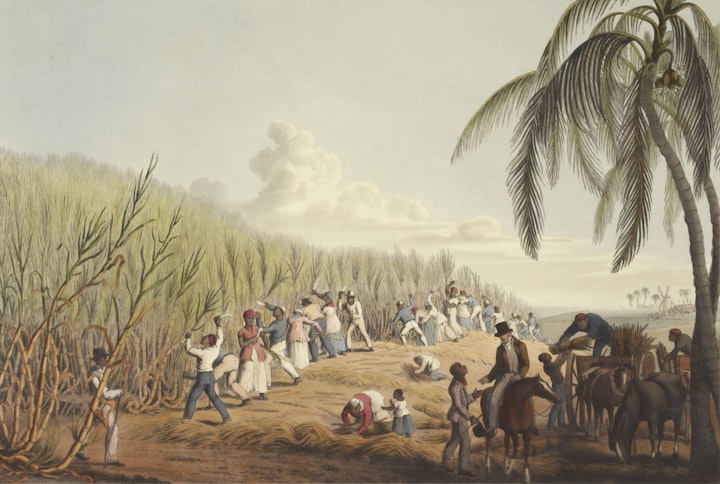The Atlantic Slave Trade
The transatlantic slave trade represents one of the darkest chapters in human history. Millions of Africans were torn from their homes, enduring unimaginable cruelty and suffering as they were transported across the ocean to a life of bondage, with devastating consequences for generations to come.

The sun dipped below the horizon, casting long shadows over the African village. The air was heavy with a mixture of anticipation and dread as families huddled together, their hearts heavy with an impending sense of loss. The traders had arrived, and with them came the promise of a fate far worse than death.
Among the villagers was a young girl named Amara. Her ebony skin glistened in the fading light, reflecting the strength and resilience of her ancestors. Little did she know that her world was about to be shattered, that the life she had known was about to be violently uprooted.
Amara's village had thrived for generations, its people deeply rooted in the rich soil of their homeland. But the insatiable greed of distant lands had set its sights on their shores. The slave traders, driven by a perverse desire for power and profit, saw human lives as mere commodities to be bought and sold.
In the dead of night, the traders descended upon the village like a swarm of vultures. The cries of families torn apart filled the air, drowning out the pleas for mercy. Amara's trembling hand was ripped from the grasp of her mother, her father's desperate eyes burned into her memory as she was forced onto a ship bound for a distant land.
The voyage across the treacherous Atlantic Ocean became a living nightmare. Amara, along with hundreds of others, was crammed into the dark, suffocating hold of the slave ship. The stench of despair hung thick in the air, mingling with the putrid smell of human waste and death. The shackles bit into her wrists, a constant reminder of her new reality as a piece of property.
Days turned into weeks, weeks into months, as the ship cut through the waves. Amara watched helplessly as her fellow captives withered away, their spirits crushed by the brutality of their existence. Hunger gnawed at their emaciated bodies, and disease spread like wildfire through the overcrowded, unsanitary conditions.
Amidst this living hell, Amara forged connections with others who shared her suffering. Together, they whispered stories of their homeland, clung to the fragments of their culture, and held onto the flickering hope that one day, their chains would be broken and they would taste freedom once more.
Finally, the ship reached its destination—a land stained with the blood and tears of countless enslaved souls. The auction block became the stage upon which their lives were bought and sold, their worth reduced to a mere dollar amount. Families were torn apart, hearts shattered, and identities stripped away.
Amara found herself on a plantation, a small cog in a vast machinery of cruelty and exploitation. Her days were filled with backbreaking labor under the scorching sun, her nights haunted by the ghosts of the lives that had been stolen. She witnessed the relentless beatings, the degradation, and the utter dehumanization of her fellow enslaved individuals.
In the midst of this darkness, a flame of resistance burned within Amara's heart. She longed for freedom, not only for herself but for those who shared her plight. She risked her life to learn to read and write, secretly passing on knowledge and empowering others with the weapon of education.
Years turned into decades, and Amara saw the ebb and flow of hope within her community. Some found solace in their faith, others in songs of resilience that echoed through the cotton fields. Yet, the scars ran deep, wounds that could never fully heal. The chains of bondage were not only physical but etched upon their souls.
As time passed, the world began to wake up to the atrocities of the transatlantic slave trade
. The voices of abolitionists grew louder, demanding an end to the heinous practice that had claimed the lives and dignity of millions. Slowly, the tide of change began to turn.
Amara lived to witness the abolition of slavery, a bittersweet victory that came too late for many. She saw the emancipation of her people, but the scars of the past remained, reminding her of the unimaginable suffering endured by generations before her.
Though Amara's story is fictional, it reflects the experiences of millions who endured the horrors of the transatlantic slave trade. Their voices, their pain, and their resilience reverberate through the annals of history, a reminder of the depths of human cruelty and the enduring spirit of those who fought for freedom and dignity.
Note: The story above is a work of fiction created to illustrate the subject of the Atlantic Slave Trade. The characters and events portrayed are fictional, but they reflect the experiences of the individuals who suffered under the transatlantic slave trade.





Comments
There are no comments for this story
Be the first to respond and start the conversation.